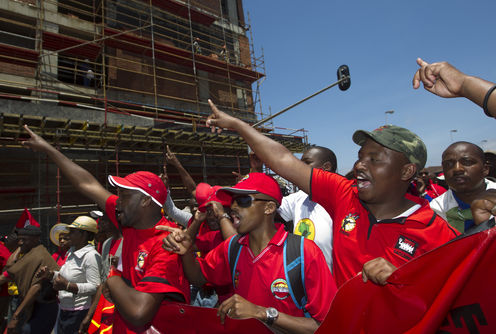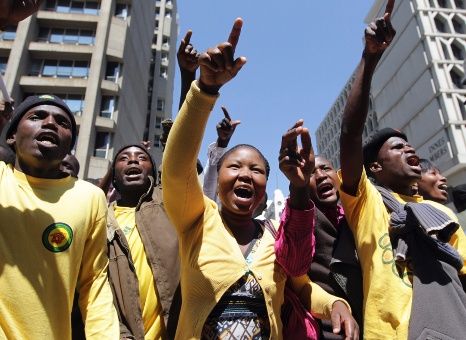Africa/ Septiembre del 2107/
Noticias/https://theconversation.com/
Do South African trade unions still represent the working class?
The South African labour landscape has undergone massive changes in the past few years that have left the country’s trade union movement almost unrecognisable from yesteryear.
The Congress of South African Trade Unions, still the country’s largest trade union federation, has been bleeding members for a while and has been shaken to the core by the exit of the National Union of Metal Workers of South Africa. This exit has led to a new formation, the South African Federation of Trade Unions. Both labour federations still claim to represent the interests of the working class.
Something else, perhaps more fundamental has been changing within South Africa’s trade union movement. The membership base has shifted significantly from one dominated by unskilled and semiskilled workers to one that shows bias towards skilled and professional workers. This is captured in a series of surveys undertaken between 1994 and 2014, before the National Union of Metal Workers’s exit.
The data shows that less than 1% of members within the trade union movement classified themselves as professional in early years of democracy. The picture had changed radically by 2008 with 20% of the respondents classifying themselves as professional. It would therefore seem that South Africa’s trade union federation had become a home for middle class civil servants, rather than a working class federation.
The evolution
A group of labour scholars has been conducting surveys of Congress of South African Trade Unions members before every parliamentary election since 1994. The intention of the survey, titled Taking Democracy Seriously, was to study the impact of union democracy on parliamentary democracy.
The data set (drawn from five surveys, with the last conducted in 2014 just before National Union of Metal Workers of South Africa was expelled) tell us much more than just what union members’ attitudes towards democracy is. It paints a complex picture of who trade unions actually represent.
At its high point, the federation had a membership of 2.2 million. This was the result of three waves of unionisation.
The first wave of members comprised of workers who were organised into the initial manufacturing unions that resulted from the militancy of the 1973 strikes.
The second wave started in 1985 with the National Union of Mineworkers – the first to organise black miners and what was to become the largest union in the country – joining the Federation of South African Trade Unions in 1985.
The third wave came with the public sector unions that emerged after 1990. This wave benefited from the Labour Relations Act of 1995 which brought public sector employees under the same dispensation as the private sector in terms of collective bargaining and organisational rights.
In the early years of democracy public sector unions were so marginal to the federation and debates in labour studies that the researchers did not even include any unions from the public sector.
The professional factor
From 1994 union members were asked to classify themselves as being professional, clerical, supervisors, skilled, semi-skilled, or unskilled. Less than 1% classified themselves as professional in 1994, 1998 and 2004.
The data reflects a major shift in the last two surveys conducted after the inclusion of public sector unions in the sample. 20% of respondents classified themselves as professional in 2008, and 19% in 2014. This constituted a fifth of federation membership base, certainly a massive shift from the early 1990s.
Those members who classified themselves as clerical remained more or less constant, with those classifying themselves as supervisors increasing slightly from 4% in 1994 to 6% in 2014.
What is interesting though, is an increase of those who classify themselves as skilled increasing from 21% in 1994 to 37% in 2014. Those who classify themselves as unskilled declined from 30% in 1994 to a mere 8% in 2014, almost equal to the members who are supervisors.
This means that while 60% of the federation was made of semi-skilled and unskilled workers in 1994, by 2014 roughly 60% classified themselves as either skilled or professional, a complete inversion.
Loss of unskilled members
What explains this major transformation in the federation’s membership composition? We explored three possible explanations.
The entry of public sector unions, representing civil servants like teachers and nurses, into the federation is a major factor. This is confirmed when one breaks down the levels of skill by whether members belong to private sector or public sector unions for the 2014 survey.
The data shows that 78% of union members who classify themselves as professionals is from public sector unions. The unskilled and semiskilled members tend to come from private sector unions.
Its clear that the increase in the number of professionals within the federation was mainly a result of the entry of public sector unions. But this factor does not provide enough of an explanation for the decline in the percentage of unskilled members. We have to look elsewhere for this.
The data suggests that the post-apartheid era facilitated upgrading of skills within the federation. The proportion of members who had Grades 5-7 declined from 15% in 1994 to a mere 2% in 2014. Those with Grades 8-10 declined from 44% in 1994 to 11% in 2014.
Members with Grades 11-12 increased from 31% in 1994 to 45% in 2014 and members with technical diplomas increased from 3% in 1994 to 20% in 2014. Those with university degrees rose from less than 1% in 1994 to 17% in 2014.
Almost 40% of the trade union members in our sample have tertiary qualifications in the form of technical diplomas or university degrees. But the skills upgrade explanation also leaves a bit of a puzzle.
Does the fact that these trade union members now have higher levels of formal qualifications mean that a much smaller proportion of the work in South Africa’s economy is now done by skilled rather than unskilled workers? The labour market data more generally does not support this assumption. We have to look elsewhere for additional explanations.
A significant portion of South Africa’s unskilled manual labour is no longer performed by trade union members. This is due to the rise of non-permanent employment through subcontracting, casual labour, or informal forms of employment.
This means that as the trade union movement was gaining skilled and professional members it was bleeding unskilled manual workers. This leaves the question: has South Africa’s labour movement become a middle class movement, rather than one that primarily represents the working class?
Fuente: https://theconversation.com/has-south-africas-labour-movement-become-a-middle-class-movement-82629
Imagen: https://lh3.googleusercontent.com/llIO1_ZVPe1P9j-rtW0UAcl7EgXBqhQt-lEyHVYcnwqP8jK2pSpAKIJennl1You9amXa=s85









 Users Today : 2
Users Today : 2 Total Users : 35459908
Total Users : 35459908 Views Today : 2
Views Today : 2 Total views : 3418467
Total views : 3418467